 LILY DAVIS: What is your name and where are you from? My name is Lily Davis, and I’m from East Lansing, Michigan. Where are you going to school, what year are you, and what are you studying? I’m a senior at Michigan State, with a History major and a minor in Women’s and Gender Studies. What internship work are you doing? I’m one of the research interns. What are you most excited about going into your internship? As one of the research interns, I'm very excited to learn more about the topics I'll be doing research on. I love the educational growth that this internship offers, not only in furthering research skills and ability, but also learning more history on the topics we'll focus on. 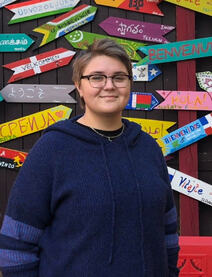 CHAR: What is your name and where are you from? My name is Char Nieberding, I'm from Columbus, Ohio. Where are you going to school, what year are you, and what are you studying? I go to school at Kalamazoo College in Kalamazoo, Michigan. I'm currently a sophomore studying History and German as my majors with a minor in Classics. What internship work are you doing? The internship work I’m doing is remote research. What are you most excited about going into your internship? I'm really excited about doing research in a non-academic setting for something that has direct bearing on the lives of regular, local people. It's super cool to gain knowledge and be able to share that with the public.  KAIT ALBERT: What is your name and where are you from? I’m Kait Albert and I’m from New Lothrop, Michigan. Where are you going to school, what year are you, and what are you studying? I’m a Michigan State senior majoring in History and Minoring in Peace and Justice Studies and Anthropology. What internship work are you doing? I’m here for a museum research internship. What are you most excited about going into your internship? I am most excited to learn more about the history of Petoskey and to strengthen my research skills. MAGGIE MOLITOR:
What is your name and where are you from? I’m Maggie Molitor and I’m from Grand Rapids, MI. Where are you going to school, what year are you, and what are you studying? I’m going into my sophomore year at Michigan State and I’m a Marketing major. What internship work are you doing? I’m doing marketing work for the museum as my internship. What are you most excited about going into your internship? I’m excited to gain real world marketing experience and to see how marketing works for a smaller business as opposed to a more corporate setting. I’m also excited to help get people excited for the history of Petoskey and the Little Traverse area.
2 Comments
Nell's Cafe was located at 438 E. Lake Street, or what is today 442 E. Lake. The restaurant was open 8:00 am to 8:30 pm, and the "lunch garden" was open from 9 to 12 pm. The advertisements are as interesting as the menu, giving us a glimpse of what life was like in Petoskey in 1919. You could rent a cottage, buy some clothes, get your hair cut or shampooed, take a bath, play billiards and get your picture taken. The taxi service was available "day and night" and one of the Doctors Reycraft (brothers) was always in the office. There were fourteen places of worship in town, many of which are still there today. Women owned and operated some businesses, including a hairdresser and women's and children's clothing establishments. The breadth of the menu is incredible. It includes a wide variety of main courses and side dishes, with twelve choices of potato. It is such fun to read the menu and decide what to order. To convert the prices into an approximation of today's prices, multiply by 15. So, what are you having for lunch? Jacob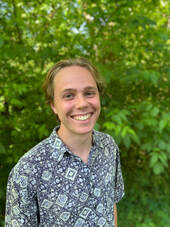 What is your name, and where are you from? My name is Jacob Aupperlee, and I am from Grandville, Michigan. Where are you going to school, and what are you studying? This fall I will be a senior at Calvin University. I am majoring in literature with a minor in philosophy. What are you most looking forward to with your position at the museum this summer? I am really excited to apply some of my writing skills to the world of marketing in a very tangible way. This summer I will be writing press releases, blog posts, and other material for the museum. I am eager to use my talents to promote local, community-based learning. What is one of your favorite historical movies or books? My favorite historical movie is probably Hacksaw Ridge. As a literature major, picking a favorite historical book is much harder. If I had to pick just one (two really), I would probably say the Maus books by Art Spiegelman. Emma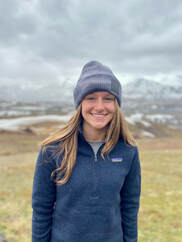 What is your name, and where are you from? Emma Petrillo. I am from Brighton, Michigan. Where are you going to school, and what are you studying? I’m going to be a junior at Michigan State and am studying Marketing with a Public Relations minor. What are you most looking forward to with your position at the museum this summer? I’m most looking forward to interacting with local businesses, as well as collaborating with fellow interns and Jane (the museum director). I’m also excited about seeing how the museum runs. What is one of your favorite historical movies or books? My favorite historical movie would be Pearl Harbor or Unbroken and not sure if this counts because it’s historical fiction but The Book Thief for book! Eleanor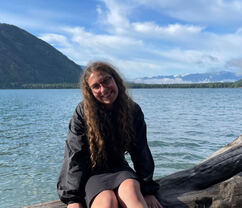 What is your name, and where are you from? Hello! My name is Eleanor Harris, and I’m from Appleton, Wisconsin. Where are you going to school, and what are you studying? I just finished my first year at Kalamazoo College, where I plan to major in history with a concentration in American studies. What are you most looking forward to with your position at the museum this summer? I’m excited to begin working as an intern to learn more about the area and the museum’s history. The project I will be focusing on this summer is researching the museum’s history to help create an online exhibit and program. I have a passion for making local history accessible to its community, which is what I plan to do this summer! What is one of your favorite historical movies or books? My favorite historical movie happens to be a German movie called Goodbye Lenin. 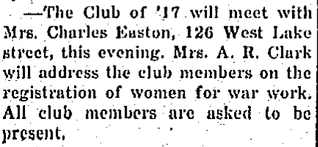 Petoskey Evening News April 9, 1918 Petoskey Evening News April 9, 1918 Mary Dalm was a teacher at Sheridan School 1917-1920. She was a member of the Club of '17, a group of 17 women who knit and sewed for the Red Cross. Mary was 23 years old in 1917. April 11, 1918 Tuesday we started to clean our apartment. We have the living room, dining room, and nearly all of the kitchen finished. Seems good to live in clean rooms, not that ours were so dirty. We always clean them every week. May and I made candy Monday night and I sent Jake a box Tuesday morning. At night we went to Club at Mrs. Grace Easton's– a Mrs. Clark talked on Woman Registration. She told us our fortunes afterward. Read our palms...told me I was going to marry a brilliant man and be very happy. Yesterday afternoon we had Mother's Meeting. We had a sociable time. I enjoyed myself very much. My children sang a few dramatic songs. Marie McGoogan's (4th grade) sang a two part song and a few danced a folk dance Hopp Mor Anika. April 15, 1918 It is very smoky today. There are forest fires at Alanson– north of here. The sun was a red ball this morning when it came up. Too smoky to shine. It was Esther's birthday Saturday. I gave a little theater party and we went to Don's Confectionary afterward. We saw Douglas Fairbanks in Reaching for the Moon. 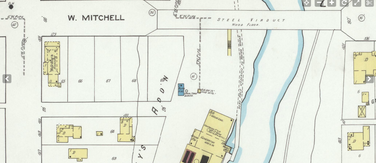 Boarding House at 123 Mitchell Street Boarding House at 123 Mitchell Street Mary and Esther boarded at 123 W. Mitchell Street (currently Mancino's). Grace Easton, who hosted the Club of '17, lived at 126 W. Lake. The Mrs. Clark who spoke at the club meeting was Jessie F. Clark, Vice President of the Emmet Equal Suffrage Committee. She and her husband Alex owned Clark's Tavern on Lake Street (currently vacant) and many suffrage meetings were held there. Don's Confectionary isn't listed in the City Guide, so we imagine Mary's friend Don worked at one of several in downtown Petoskey. 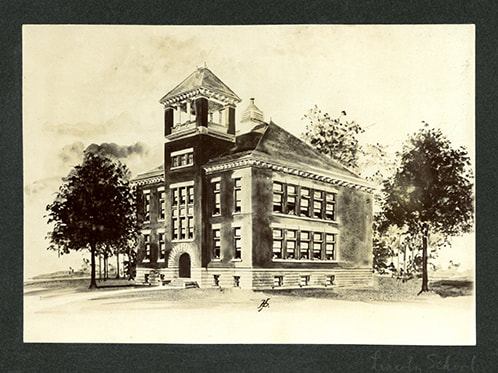 Sheridan School at the corner of Sheridan and Howard Streets Petoskey Sheridan School at the corner of Sheridan and Howard Streets Petoskey The former Sheridan School burned down, and the site is currently used for the administration building. Notice the arch on the school, which is still visible today at the Spitler Building. 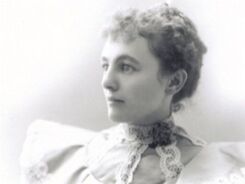 Minnie Rosenthal, president of the Woman's Club in 1917 Minnie Rosenthal, president of the Woman's Club in 1917 The minutes of the Woman's Club meeting were transcribed by Co-Executive Director Jane Garver from a notebook of handwritten notes. All original spelling, capitalization, and punctuation has been preserved. Click the blue links for more information. The Woman’s Club met at the home of Mrs. Quinlan. The meeting was called to order by the president, Mrs. Rosenthal. Minutes read and approved. A communication from Mrs. Hunsbarger was read, tendering her resignation from the Club. A motion was made to accept it- carried. Mrs. Bain was elected secretary to fill the vacancy left by Mrs. Hunsbarger. Mrs. Ferris was elected a member of the Club and the secretary instructed to notify her. A motion was made that the Club have a committee to visit the sick- carried. It was moved that the officers of the Club constitute that committee- carried. The president appointed Mrs. Darling and Mrs. M. Rosenthal to act as the flower committee. A motion was made that the Club eliminate the program after the holidays and have articles from leading periodicals read by the chairman of the day, and do Red Cross work- carried. The president appointed Mrs. Levinson, Mrs. Nihart, and Mrs. Wilson to act as a committee for supplying the club with work from the Red Cross rooms. It was moved that the program be left over for the next year, the chairman of last year’s committee working with the new committee. Roll call was responded to with United States Presidents. The ladies did red-cross work during the program which was in charge of Mrs. Nihart. The subject being American life since 1876. Mrs. Rosenthal read a paper on Southern California showing some views of the places she visited while there. Mrs. Mesick gave the biography of her guest Miss Clara Grayson. Then followed current events about historical places, after which our hostess, Mrs. Quinlan, served tea and wafers. Aileen S. Nihart, Sec. Pro Tem Dues paid Mrs. Darling $1.00 Mrs. Barber $1.00
Passenger Pigeons Nest in Petoskey by Harriet Kilborn First published in 1954 For centuries the pigeons ranged the forested areas of the North American continent in multitudes that stagger the imagination. Then, within a span of twenty-five years in the 19th century, were seen in continually diminishing numbers until not a trace of them was left. The last living specimen died in the Cincinnati Zoological Garden September 1, 1914. The species was extinct. The unusual feature of the Petoskey nesting in 1878 was that it was the last great nesting on record. The birds that survived the slaughter took wing and disappeared to the north. The pigeon flock coming into the Petoskey area to nest for the second consecutive year, that spring of '78, was miles long and so thick as to actually darken the sky. The rustling sound of their wings was likened to an approaching tempest. The spectacle was repeated twice daily, in the early morning and late afternoon, when they were in flight to and from their feeding grounds, often times many miles away from the nesting area. During the morning flights the Little Traverse Bay bluffs looked like a skirmish line. The shooters stood so close together, and there was such a continual roar, from the flying birds and the shooting, that no one knew who killed the birds. Each man had all the boys he could get as retrievers, and the one with the most boys got the most birds. The guns were all muzzleloaders, and every now and then, in the hurry to load and fire, a ramrod would be shot into the air. Shooting at the pigeons in flight was a popular sport. With the exception of the use of boys as retrievers, the bluff scene was duplicated in Audubon’s description of a flight in Kentucky he witnessed in 1813. It was at this time Audubon estimated the flock to contain over two billion birds, and reckoned they would eat over seven million bushels of nuts, acorns, grains, and/or seeds per day. The nesting area was a place of uproar and confusion. The birds settled on the trees in such number that large trees as well as branches and limbs crashed to the ground, destroying the birds underneath. This and the feeding spots were the places where the birds were slaughtered by the tens of thousands. Netting pigeons and shipping them to the large city markets became a full-scale commercial business from the 1860s on. It has been estimated that from four hundred to one thousand men were engaged in the business. Railroads and telegraph made it possible for the commercial operators to arrive practically with the pigeons. They came to the Petoskey nestings the springs of 1877 and 1878 and the slaughter was on here, as it had been elsewhere in previous years. The Petoskey area Mossbacks were hungry, many of them. If it had not been for relief supplies received during the winter, they would have had to leave or starve. Money was gone, there was no work available in the near vicinity of their homes, and they were still busy clearing the homestead lands and planting crops. The pigeons who came from the sky were a crop to be harvested. Working with the professional pigeon netters, fish nets fifty to seventy feet long were rigged in such a way as to trap the pigeons in large numbers at one swoop. All through the country the homesteaders decoyed the pigeons, caught them and sold them. Wagon load after wagon load rumbled into town. Live birds were packed and shipped in crates. Dead ones were picked, packed in barrels, and boated out. Various estimates of the number of birds shipped were made at the time and the largest was one million birds. It isn’t a pretty picture, but each season’s catch put from $30,000 to $40,000 in circulation and the amount was sufficient to last the settlers until the first crops were harvested. Early on-the-spot accounts show that by 1878 steps were being taken to try to stop the wholesale slaughter of the nesting grounds. A company of men, including the US Marshall, quietly checked in at the Cushman House in Petoskey. Following their arrival the Sheriff was kept on the hop bringing in all those they tagged for arrest. The local paper warned, after the Marshall’s party had departed, that new men were being sent in and that all who wished to catch pigeons had best stay the proper distance away from the forbidden area. A game law was apparently on the books at that time which made it illegal to go into the nesting area proper after the birds. This last great nesting at Petoskey is reported to have covered something like 100,000 to 150,000 acres. The wild pigeon, once the most abundant species ever known in any country, is no more. Its story is so incredible as to seem a legend. Perhaps in centuries to come it will be told and retold as a part of the folk-lore of the early Americans. |
